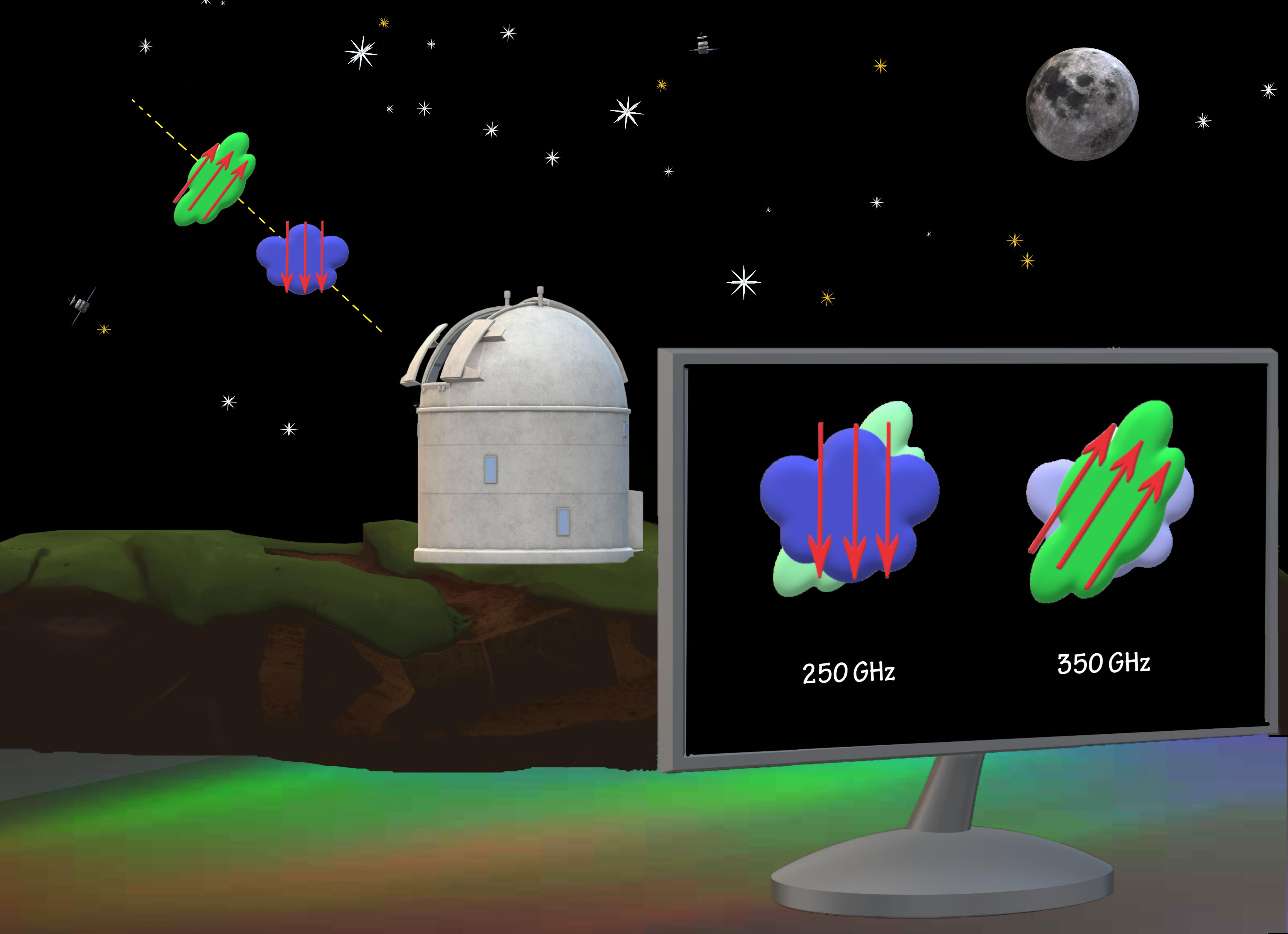 |
credit:Paraskevi Kallemi |
Polarized light emitted by Galactic interstellar dust acts as a veil obscuring our view of microwave emission from the early Universe - the cosmic microwave background (CMB), often called the Big Bang "ashes". An important breakthrough in our understanding of the complexity of this foreground emission has been achieved by an international collaboration of scientists from the Institute of Astrophysics of the Foundation for Research and Technology – Hellas (IA-FORTH) and the University of Crete in Greece, Princeton University, Institute for Advanced Study, and Caltech in the USΑ, and the University of Oslo in Norway. The study, led by IA-FORTH's Dr. Vincent Pelgrims, used data from ESA's Planck mission and neutral Hydrogen emission to show that the rich 3-dimensional structure of interstellar gas has a strong effect on polarization from dust. "When more than one clouds intersect a line of sight", Dr. Pelgrims said, "and these clouds have different emission spectra and misaligned magnetic fields, then the angle at which this radiation is polarized turns as we move from one frequency to the next." This effect was predicted in 2015 by IA-FORTH scientists and U. Crete faculty Konstantinos Tassis and Vasiliki Pavlidou (see Fig. 1), but this is the first time its signature is explicitly detected in observational data. It also demonstrates the difficulties and pitfalls in the proper treatment of Galactic foregrounds since a simple scaling of the polarized emission at one frequency to infer the emission at another frequency (an assumption frequently used in the past) is incorrect and should not be applied.
 |
Figure 1: When a single line of sight crosses two clouds with misaligned magnetic fields and different properties (temperature, amount of dust, dust composition), the polarization angle of the total dust emission is not the same in all frequencies, but turns as we go from one frequency to the next. |
"This discovery was only now made possible thanks to breakthrough studies of the interstellar medium by our overseas co-authors: the work of Dr. Gina Panopoulou, Hubble Fellow at Caltech, and U. Crete alumna, which allowed us to determine which lines of sight intersect multiple clouds; along with the findings by Dr. Susan Clark, Fellow of the Institute for Advanced Study, and Dr. Brandon Hensley, Spitzer Fellow at Princeton, which enabled us to indirectly infer the direction of magnetic fields in different interstellar clouds" said Prof. Pavlidou.
 |
Figure 2: Emission from neutral hydrogen can be used to determine how many clouds intersect a line of sight, and its morphology can be used to infer the magnetic field direction in each cloud. |
These analyses used the emission from neutral hydrogen, the most abundant ingredient in interstellar clouds, to trace the location of the clouds. The spectrum of this emission reveals the number of distinct clouds along each sightline, and its morphology can be used as a proxy for the magnetic field direction (See Fig. 2). With this information at hand for each direction in the sky, the scientists could select all sightlines that were susceptible to the effect, by intersecting more than one clouds with misaligned magnetic fields. Next, they looked at the difference in polarization angle between two frequencies that Planck observed, and where emission from interstellar dust dominates: 217 GHz, and 353 GHz. They found that in the selected sightlines the difference in polarization angle was much more pronounced than elsewhere in the sky. “Not only that,” added Dr. Pelgrims, “but we were able to show that the larger the misalignment between clouds, the larger the difference in polarization angle between frequencies” . “Now that we have demonstrated that the effect is visible in the Planck data, the need to find ways to account for it when cleaning microwave maps before using them to study the early Universe got more urgent", said Prof. Tassis. "Thankfully, the PASIPHAE experiment, which we expect to have running this year, will do exactly that." PASIPHAE is an international collaboration between IA-FORTH and U. Crete in Greece, Caltech in the U.S., IUCAA in India, SAAO in South Africa, and the University of Oslo in Norway. It will measure with unprecedented efficiency and accuracy the polarization of millions of stars in our Galaxy. Combining the polarization measurements with the amazingly accurate distances we now have for all those stars thanks to ESA’s Gaia mission, we can distinguish between stars in front of clouds, in between clouds, and behind clouds. This allows us to disentangle the imprint of each cloud on stellar polarizations, and directly derive the magnetic field direction in each cloud, thus producing the first 3D map of the magnetic field of our Galaxy. The study has been accepted for publication by Astronomy and Astrophysics and is available here. Reference: V. Pelgrims, S. E. Clark, B. S. Hensley, G. V. Panopoulou, V. Pavlidou, K. Tassis, H.K. Eriksen, I. K. Wehus “Evidence for line-of-sight frequency decorrelation of polarized dust emission in Planck data” 2021, A&A, 647, A16 Contact person: Prof. K. Tassis, University of Crete & Institute of Astrophysics , FORTH https://www.ia.forth.gr/people/tassis










